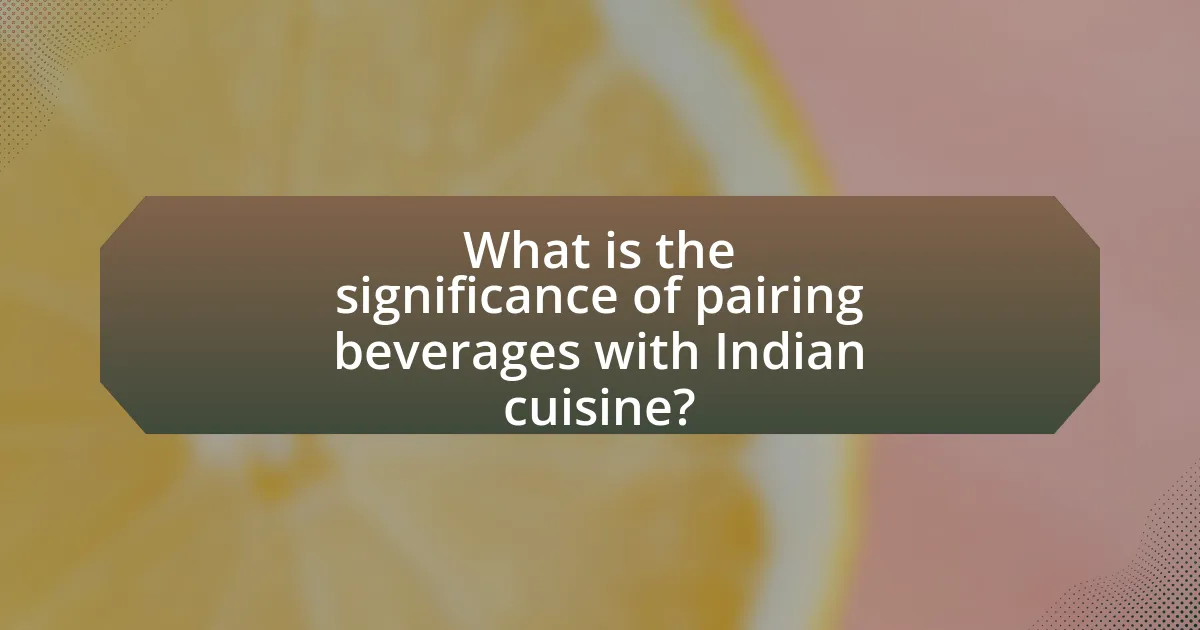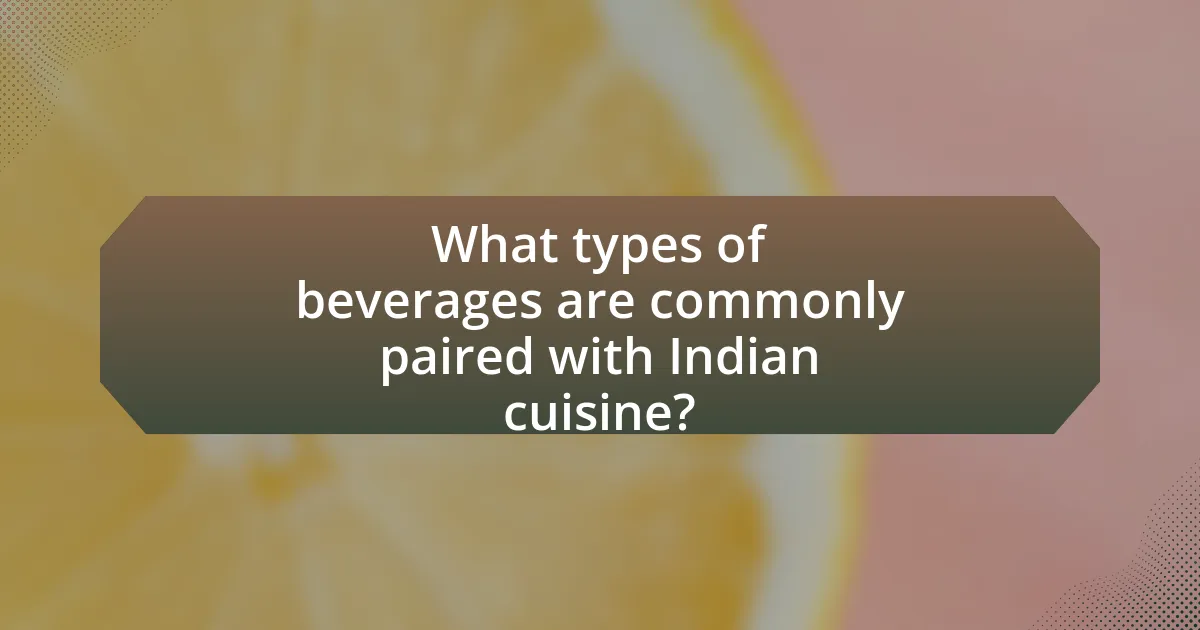The article focuses on the significance of pairing beverages with Indian cuisine, emphasizing how thoughtful combinations can enhance the dining experience by complementing the complex flavors of the dishes. It explores various aspects of beverage pairing, including the influence of spices, heat, acidity, and sweetness in Indian food, as well as the role of texture in beverage choices. The expertise of sommeliers in recommending suitable drinks is highlighted, along with the training they undergo to master beverage pairings. Additionally, the article discusses specific beverages that pair well with popular Indian dishes, including both alcoholic and non-alcoholic options, and provides practical tips for effective pairing at home while avoiding common mistakes.

What is the significance of pairing beverages with Indian cuisine?
Pairing beverages with Indian cuisine enhances the overall dining experience by complementing and balancing the complex flavors of the dishes. Indian cuisine is characterized by its diverse spices and rich flavors, which can be effectively matched with beverages to either contrast or harmonize these elements. For instance, a spicy curry may be paired with a cooling lassi or a crisp beer to mitigate heat, while a sweet dessert like gulab jamun can be complemented by a fragrant chai or dessert wine. This thoughtful pairing not only elevates the taste but also enriches the cultural experience, as beverages often play a significant role in Indian culinary traditions.
How does beverage pairing enhance the dining experience?
Beverage pairing enhances the dining experience by complementing and elevating the flavors of the food. When beverages are chosen to match the taste profiles of dishes, they can enhance the overall sensory experience, making flavors more pronounced and enjoyable. For example, pairing a spicy Indian curry with a sweet Riesling can balance the heat and create a harmonious taste experience. Studies have shown that appropriate beverage pairings can improve meal satisfaction and increase the perception of flavor complexity, leading to a more memorable dining experience.
What flavors in Indian cuisine should be considered when pairing beverages?
When pairing beverages with Indian cuisine, key flavors to consider include spices, heat, acidity, and sweetness. Indian dishes often feature a complex blend of spices such as cumin, coriander, and cardamom, which can influence the choice of beverage. For example, a spicy curry may pair well with a refreshing lager or a sweet Riesling to balance the heat. Additionally, the acidity in dishes like tamarind chutney or yogurt-based sauces can complement wines with higher acidity, such as Sauvignon Blanc. Sweetness from dishes like butter chicken can be enhanced by pairing with a slightly sweet beverage, such as a fruity cocktail or a dessert wine. These flavor profiles are essential for creating harmonious pairings that enhance the overall dining experience.
How do different textures in food influence beverage choices?
Different textures in food significantly influence beverage choices by affecting the overall sensory experience and palate balance. For instance, creamy textures in dishes, such as paneer or rich curries, often pair well with beverages that have acidity, like a crisp white wine or a refreshing lager, to cut through the richness. Conversely, crunchy textures found in fried snacks or salads may be complemented by lighter, effervescent drinks, such as sparkling water or a light beer, which enhance the textural contrast. Research indicates that texture impacts flavor perception and can alter the way beverages are experienced, making it crucial to consider texture when selecting complementary drinks.
Why is a sommelier’s expertise important in beverage pairing?
A sommelier’s expertise is crucial in beverage pairing because it ensures that the selected drinks enhance the flavors of the food. This expertise is built on extensive knowledge of various beverages, including wines, spirits, and non-alcoholic options, as well as an understanding of flavor profiles and culinary techniques. For instance, sommeliers can identify how the acidity in a wine can complement the spices in Indian cuisine, creating a harmonious dining experience. Their training often includes formal education and practical experience, allowing them to make informed recommendations that elevate the overall meal.
What training do sommeliers undergo to specialize in beverage pairing?
Sommeliers undergo extensive training that includes formal education, practical experience, and sensory evaluation to specialize in beverage pairing. This training typically involves completing programs from recognized institutions such as the Court of Master Sommeliers or the Wine & Spirit Education Trust, where they learn about wine regions, grape varieties, and flavor profiles. Additionally, sommeliers engage in tastings and food pairing exercises to develop their palate and understanding of how different beverages complement various cuisines, including Indian cuisine. This hands-on experience is crucial for mastering the art of pairing beverages with food, as it allows sommeliers to apply theoretical knowledge in real-world settings.
How can a sommelier’s recommendations elevate traditional Indian dishes?
A sommelier’s recommendations can elevate traditional Indian dishes by expertly pairing them with complementary beverages that enhance the flavors and overall dining experience. For instance, the acidity of a Sauvignon Blanc can balance the richness of creamy dishes like butter chicken, while a spicy Riesling can complement the heat of dishes such as vindaloo. Research indicates that proper beverage pairing can enhance flavor perception, making the meal more enjoyable. According to a study published in the Journal of Culinary Science & Technology, effective pairings can significantly improve the overall satisfaction of a meal, demonstrating the sommelier’s role in maximizing the culinary experience.

What types of beverages are commonly paired with Indian cuisine?
Commonly paired beverages with Indian cuisine include lassi, chai, and various types of beer and wine. Lassi, a yogurt-based drink, complements spicy dishes by providing a cooling effect. Chai, a spiced tea, enhances the flavors of many Indian meals. Additionally, light lagers and wheat beers are often chosen to balance the heat of curries, while aromatic white wines like Riesling or Gewürztraminer can match the complexity of Indian spices. These pairings are supported by culinary traditions that emphasize balancing flavors and enhancing the dining experience.
What role do wines play in pairing with Indian dishes?
Wines play a significant role in enhancing the flavors of Indian dishes through complementary pairing. The diverse spices and rich flavors in Indian cuisine can be balanced by selecting wines that either contrast or complement these elements. For example, a fruity Riesling can offset the heat of spicy curries, while a full-bodied red like Cabernet Sauvignon can stand up to the robust flavors of grilled meats. Studies indicate that the right wine pairing can elevate the dining experience by harmonizing taste profiles, making the meal more enjoyable.
Which wine varieties complement spicy Indian flavors?
Riesling and Gewürztraminer are wine varieties that complement spicy Indian flavors effectively. Riesling, particularly when off-dry, balances the heat of spices with its sweetness and acidity, enhancing the overall dining experience. Gewürztraminer, known for its aromatic profile and floral notes, pairs well with rich and spicy dishes, providing a contrast that highlights the complexity of Indian cuisine. Both varieties have been recognized by sommeliers for their ability to harmonize with the bold flavors found in Indian dishes, making them ideal choices for pairing.
How does the sweetness of wine affect the overall meal experience?
The sweetness of wine significantly enhances the overall meal experience by balancing flavors and complementing the dish’s profile. Sweet wines can counteract spicy and savory elements commonly found in Indian cuisine, creating a harmonious palate. For instance, a Riesling with a touch of sweetness can soften the heat of spicy curries, making the meal more enjoyable. Studies show that pairing sweet wines with spicy foods can enhance the perception of sweetness and reduce the perception of heat, leading to a more balanced dining experience.
What non-alcoholic options are suitable for pairing with Indian food?
Non-alcoholic options suitable for pairing with Indian food include mango lassi, masala chai, and coconut water. Mango lassi, a yogurt-based drink, complements the spices in Indian dishes, providing a cooling effect. Masala chai, with its blend of spices and tea, enhances the flavors of savory dishes. Coconut water offers a refreshing contrast to the heat of spicy foods, making it an excellent choice. These beverages are commonly enjoyed in Indian cuisine and are known for their ability to balance flavors effectively.
How do traditional Indian beverages enhance the meal?
Traditional Indian beverages enhance meals by complementing the flavors and textures of the cuisine. For instance, beverages like lassi, a yogurt-based drink, provide a cooling effect that balances the heat of spicy dishes, while chai, a spiced tea, can elevate the overall dining experience through its aromatic qualities. Additionally, traditional drinks such as buttermilk aid in digestion, making them beneficial alongside rich meals. The pairing of these beverages with specific dishes is rooted in cultural practices, where the right beverage not only enhances taste but also promotes a harmonious dining experience.
What modern non-alcoholic drinks can be paired with Indian cuisine?
Modern non-alcoholic drinks that can be paired with Indian cuisine include masala chai, mango lassi, and coconut water. Masala chai, a spiced tea, complements the rich flavors of Indian dishes, while mango lassi, a yogurt-based drink, balances the heat of spicy foods. Coconut water offers a refreshing contrast to the bold spices commonly found in Indian cuisine. These pairings enhance the dining experience by harmonizing flavors and providing refreshing alternatives to alcoholic beverages.

How can one effectively pair beverages with specific Indian dishes?
To effectively pair beverages with specific Indian dishes, one should consider the flavor profiles and spice levels of the dishes. For example, rich and creamy dishes like butter chicken pair well with sweet wines such as Riesling or Gewürztraminer, which balance the spices. Conversely, spicy dishes like vindaloo benefit from refreshing beverages like lager or a citrusy gin and tonic, as these help to cleanse the palate. Additionally, traditional beverages like lassi complement many Indian meals, providing a cooling effect against heat. This pairing strategy is supported by the principle that contrasting flavors can enhance the overall dining experience, making the meal more enjoyable.
What are the best beverage pairings for popular Indian appetizers?
The best beverage pairings for popular Indian appetizers include beer, wine, and traditional drinks like lassi and chai. For spicy appetizers such as samosas, a light lager or wheat beer complements the heat, while a crisp Sauvignon Blanc balances flavors in dishes like paneer tikka. Lassi, a yogurt-based drink, pairs well with rich, creamy appetizers, and chai enhances the experience of savory snacks like pakoras. These pairings are supported by the flavor profiles of the beverages, which either contrast or complement the spices and textures of the appetizers, enhancing the overall dining experience.
How do flavors in appetizers dictate beverage choices?
Flavors in appetizers significantly influence beverage choices by creating complementary or contrasting taste experiences. For instance, spicy appetizers, common in Indian cuisine, often pair well with beverages that can balance heat, such as sweet wines or creamy cocktails. Research indicates that pairing beverages with food enhances the overall dining experience, as flavors interact to either elevate or neutralize each other. A study published in the Journal of Culinary Science & Technology highlights that acidity in beverages can cut through rich or fatty appetizers, making them more palatable. Thus, the specific flavors present in appetizers guide the selection of beverages to achieve a harmonious balance.
What specific beverages work well with vegetarian starters?
Specific beverages that work well with vegetarian starters include light white wines, such as Sauvignon Blanc and Pinot Grigio, as well as sparkling water and herbal teas. These beverages complement the fresh and vibrant flavors typically found in vegetarian starters. For instance, Sauvignon Blanc’s acidity enhances the taste of dishes like vegetable pakoras, while sparkling water cleanses the palate between bites. Herbal teas, such as mint or chamomile, provide a soothing contrast to spicier vegetarian options, making them an excellent choice for pairing.
How should one approach pairing beverages with main courses in Indian cuisine?
To approach pairing beverages with main courses in Indian cuisine, one should consider the flavor profiles and spice levels of the dishes. Indian cuisine is characterized by its diverse spices and rich flavors, which can be complemented by beverages that either contrast or enhance these elements. For example, a spicy curry pairs well with a refreshing lassi or a light beer, as the coolness of the beverage balances the heat. Conversely, a rich, creamy dish like butter chicken can be complemented by a full-bodied white wine, such as Chardonnay, which matches the dish’s richness. This method of pairing is supported by the principle that beverages should either cleanse the palate or enhance the overall dining experience, ensuring that the flavors of both the food and drink are highlighted.
What factors should be considered when pairing drinks with curry dishes?
When pairing drinks with curry dishes, consider the spice level, flavor profile, and richness of the curry. The spice level influences the drink’s ability to complement or contrast the heat; for example, sweeter beverages like Riesling can balance spicy curries. The flavor profile, whether it is earthy, tangy, or creamy, should guide the choice of drink; for instance, a tangy curry pairs well with a crisp lager. Additionally, the richness of the curry, such as those made with coconut milk, often pairs better with lighter drinks like sparkling water or dry white wines to avoid overwhelming the palate.
How do regional variations in Indian cuisine affect beverage pairings?
Regional variations in Indian cuisine significantly influence beverage pairings by aligning flavors and ingredients with complementary drinks. For instance, the spicy and rich dishes of North India, such as butter chicken, pair well with sweet lassi or robust red wines, which help balance the heat. In contrast, the lighter, coconut-based curries of South India are often best complemented by crisp white wines or refreshing beers, which enhance the dish’s subtle flavors. This alignment is supported by the diverse use of spices and cooking techniques across regions, which dictate the flavor profiles of both food and beverages, ensuring a harmonious dining experience.
What tips can help in mastering beverage pairings with Indian cuisine?
To master beverage pairings with Indian cuisine, focus on balancing flavors and considering the spice levels of dishes. Indian cuisine often features bold spices and rich flavors, so pairing beverages that complement or contrast these elements enhances the dining experience. For example, a crisp, dry white wine like Sauvignon Blanc can cut through the richness of creamy curries, while a sweet Riesling can balance spicy dishes. Additionally, traditional beverages like lassi or chai can provide a refreshing counterpoint to heat. Understanding the regional variations in Indian cuisine also helps; for instance, pairing lighter beverages with coastal dishes from regions like Goa is effective.
How can one experiment with different pairings at home?
To experiment with different pairings at home, one can start by selecting various Indian dishes and matching them with a range of beverages, such as wines, beers, or non-alcoholic drinks. For instance, pairing spicy curries with off-dry Riesling can enhance the flavors, as the wine’s sweetness balances the heat. Additionally, one can keep a tasting journal to note the flavor profiles and personal preferences for each pairing, which helps in refining choices over time. This method is supported by the principle that complementary flavors can elevate the dining experience, as seen in culinary studies that emphasize the importance of balance in food and beverage pairings.
What common mistakes should be avoided when pairing beverages with Indian food?
Common mistakes to avoid when pairing beverages with Indian food include selecting overly sweet drinks, which can clash with the complex spices in the cuisine. Additionally, pairing heavy, full-bodied wines with lighter dishes can overwhelm the flavors, while choosing beverages that are too acidic may accentuate the heat of spicy foods. It is also a mistake to ignore regional pairings; for instance, pairing a rich curry with a light lager may not enhance the dining experience. Understanding the balance of flavors is crucial, as certain beverages can either complement or detract from the intricate taste profiles of Indian dishes.
